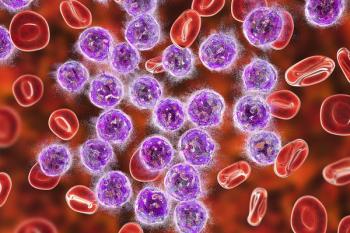
Oncology NEWS International
- Oncology NEWS International Vol 9 No 5
- Volume 9
- Issue 5
Molecular Targeting Used in Search for New Cancer Therapies
WASHINGTON-The ongoing revolution in knowledge about the cellular processes that lead to cancer has created a new and potentially far more efficient approach to finding effective therapeutic agents, said Edward A. Sausville, MD, PhD, associate director of the NCI’s Developmental Therapeutics Program.
WASHINGTONThe ongoing revolution in knowledge about the cellular processes that lead to cancer has created a new and potentially far more efficient approach to finding effective therapeutic agents, said Edward A. Sausville, MD, PhD, associate director of the NCIs Developmental Therapeutics Program.
Speaking at a symposium at the Annual Meeting of the American Association for the Advancement of Science (AAAS), Dr. Sausville contrasted the old, inefficient empirical approach of screening and testing candidate drugs with the new approach based on molecular targets.
Traditionally, Dr. Sausville said, screening compounds for anticancer potential has focused on seeking signs of anticancer activity, specifically the ability to shrink tumors. This research model has poor predictive power because of the poor correlation between agents efficacy in animal models and in humans, he said.
In some cancer models, such as breast, the traditional screening process has been very unreliable in predicting clinical results, he said, while in others, such as non-small-cell lung cancer, it has been somewhat more predictive, but has not produced striking results, he added.
The New Approach
The new approach to drug development targets therapeutic agents against specific cancer-related processes within the cells. The goal is to identify molecules that can be critically directed at the processes that actually drive neoplasms, Dr. Sausville said. Such a process will reveal clinical usefulness much earlier in the development process, he said.
The bcr-abl fusion protein, for example, is known to be expressed in certain leukemias, he said. It acts as a kinase mediating cellular growth in these neoplasms but not in normal cells. Two generations of synthetic drug development have produced STI 571, a protein that has shown activity in mice and also has produced promising human data in phase I trials in chronic myelogenous leukemia, Dr. Sausville said.
Todays understanding of cell mechanisms provides a rich tapestry of other targets, Dr. Sausville remarked. Onco-genes, such as ras, for example, appear in mutated form in a large percentage of cancers, including 90% of breast cancers and 40% to 60% of various other cancers. A number of potential inhibitors have been identified, he said, although it is as yet unclear whether any will show the desired specificity against this oncogene.
Such abnormal gene expression serves as the fingerprint of cancer cells, he said, and can show researchers where to look for molecular targets within cancer cells. Neuroblastoma, for example, shows a genetic difference that might serve as a useful target, he noted.
The fact that molecular patterns of activity unique to cancer cells are now known to cut across cell types makes it possible to select drugs with specific activities and target them at appropriate cellular molecules, he said. Algorithms that compare the molecular patterns of activity of standard agents are helping to define categories of compounds according to their action. Such information also provides insight into how to build molecules to attack specific molecular targets.
Dr. Sausville predicted that genetic libraries (see box ) will allow researchers to assess compounds according to the molecular structure of their targets. By the time these candidate compounds enter clinical trials, their likelihood of acting within human cancer cells will already be clear.
The CGAP Project
To help streamline and generalize the process of searching for molecular targets for anticancer agents, the NCIs Cancer Genome Anatomy Project (CGAP) is creating a large library of cancer gene sequences.
These are rapidly being placed in the public domain on a CGAP website, maintained by the National Library of Medicine (
This genetic library will become a tremendously interesting and important engine of drug discovery, capable of revealing many genes associated with specific tumor types, Dr. Edward Sausville said in his AAAS presentation.
This new approach to drug development will also open the way for reassessing and improving compounds studied in the past, he said.
Articles in this issue
over 25 years ago
HRT Not Associated with Lower Survival After Breast Cancerover 25 years ago
Age No Contraindication to High-Dose Therapy in Myelomaover 25 years ago
ASCO Urges Passage of Patient’s Bill of Rightsover 25 years ago
RT Not Necessarily an Impedance to Breast Reconstructionover 25 years ago
New Adjunctive Regimens for Breast Cancer Treatment Are Under Studyover 25 years ago
NCCN Prostate Cancer Practice Guidelines Revisedover 25 years ago
ERT Does Not Increase Endometrial Cancer Recurrenceover 25 years ago
Radiochemotherapy/Transplant in Low-Grade Lymphomasover 25 years ago
Fish Oil Supplements May Improve Cancer Therapies’ Effectivenessover 25 years ago
Study of Dying Cancer Patients Reveals Importance of RitualsNewsletter
Stay up to date on recent advances in the multidisciplinary approach to cancer.





















































































